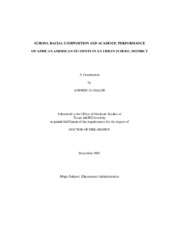| dc.contributor.advisor | Skrla, Linda | |
| dc.contributor.advisor | Tolson, Homer | |
| dc.creator | Osagie, Andree O. | |
| dc.date.accessioned | 2010-01-15T00:10:01Z | |
| dc.date.accessioned | 2010-01-16T00:36:08Z | |
| dc.date.available | 2010-01-15T00:10:01Z | |
| dc.date.available | 2010-01-16T00:36:08Z | |
| dc.date.created | 2007-12 | |
| dc.date.issued | 2009-05-15 | |
| dc.identifier.uri | https://hdl.handle.net/1969.1/ETD-TAMU-2484 | |
| dc.description.abstract | The purpose of this study was to investigate the differences in the academic
performance of economically disadvantaged African-American students attending
schools with distinct racial composition in selected inner-city Texas high schools based
on the information available in the Academic Excellence Indicator System (AEIS)
database. The degree to which certain schools’ racial compositions may impact the
achievement of economically disadvantaged African-American students was explored.
The study was conducted in order examine the academic performance of
economically disadvantaged African-American student groups in three large,
comprehensive high schools with distinct ratios of school racial compositions. The
analyses of student performance data in these three educational settings over three years
offers insight into whether school racial composition affects the academic achievement
of economically disadvantaged African-American students.
A quantitative, two factor factorial (with repeat on the last factor) design was
used to answer the questions posed. A mixed-model analysis of variance (ANOVA) was
employed to analyze school and student level differences between the percentage of
minority students in a school and the academic outcomes. Specifically, the reading and mathematics TAKS scores of economically disadvantaged African-American students
from three high schools with distinct ratios of school racial composition were compared
and analyzed. The final sample included 428 African-American students. The first
school had a racial composition of 80/20, with African-Americans being the minority.
The second school had a balanced racial composition (defined as “30/30/30”), and the
third school’s racial composition was 30/70, with African-Americans being the majority.
The most important finding in this study is that the differences in the reading and
math performance of economically disadvantage African-American high school students
attending schools with different racial composition are statistically significant. The
researcher observed an increase in the average academic performance of African-
American students as the concentration of minority students in the schools was reduced.
Although the effect of school racial composition was minimal, the findings indicate that
(even after controlling the effects of schools and students’ demographic factors by
holding these variables constant) reading and math TAKS scores were consistently
higher in the 80/20 school than in the 30/30/30 school, followed by the 30/70 school. | en |
| dc.format.medium | electronic | en |
| dc.format.mimetype | application/pdf | |
| dc.language.iso | en_US | |
| dc.subject | School Racial Composition | en |
| dc.title | School racial composition and academic performance of african american students in an urban school district | en |
| dc.type | Book | en |
| dc.type | Thesis | en |
| thesis.degree.department | Educational Administration and Human Resource Development | en |
| thesis.degree.discipline | Educational Administration | en |
| thesis.degree.grantor | Texas A&M University | en |
| thesis.degree.name | Doctor of Philosophy | en |
| thesis.degree.level | Doctoral | en |
| dc.contributor.committeeMember | Carter, Norvella | |
| dc.contributor.committeeMember | Collier, Virgina | |
| dc.type.genre | Electronic Dissertation | en |
| dc.type.material | text | en |
| dc.format.digitalOrigin | born digital | en |


